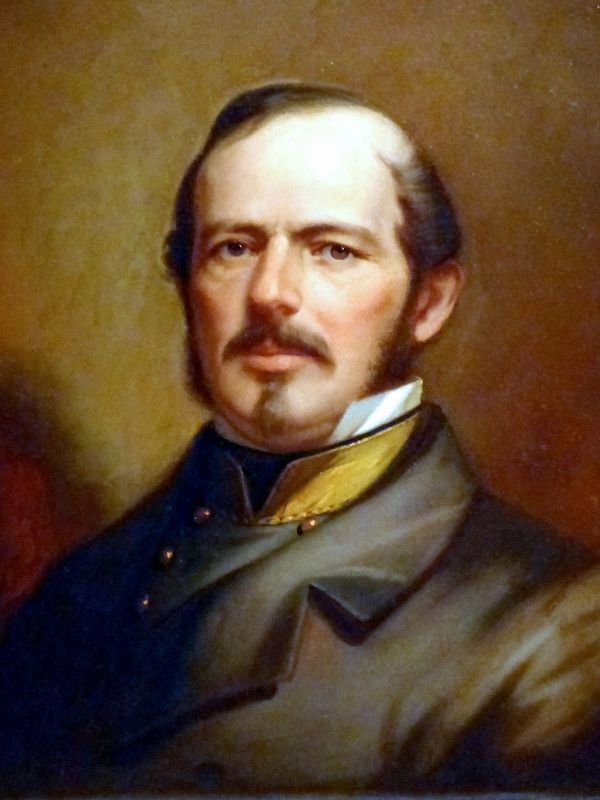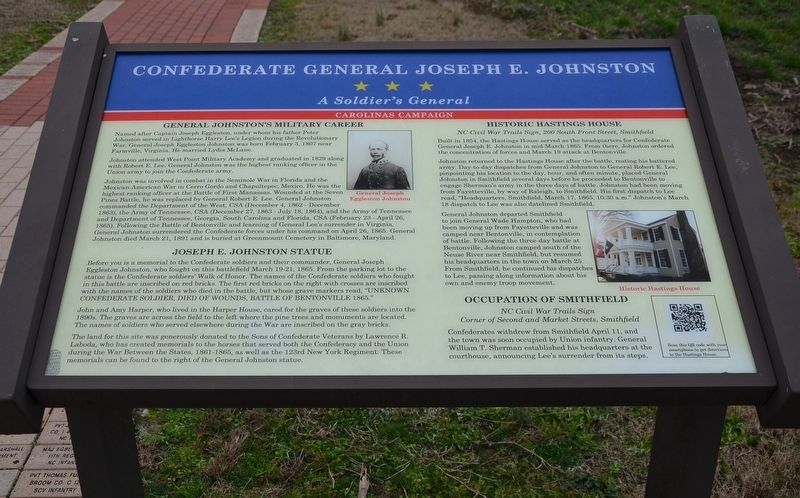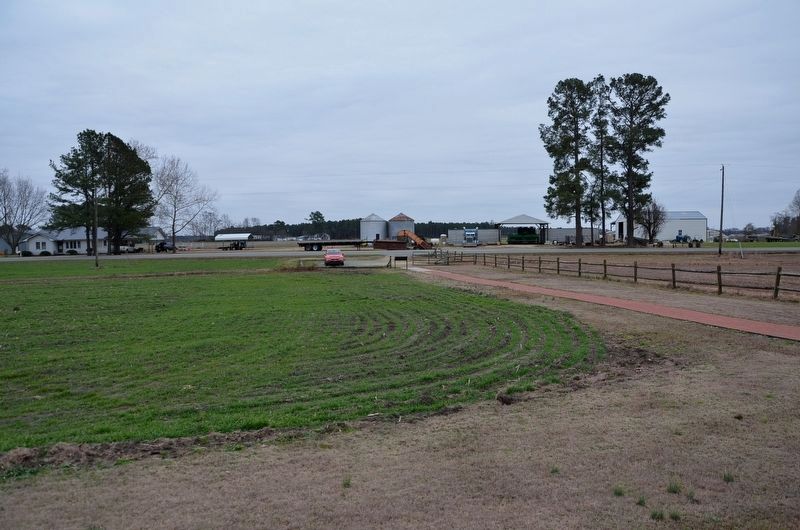Near Four Oaks in Johnston County, North Carolina — The American South (South Atlantic)
Confederate General Joseph E. Johnston
A Soldier's General
— Carolinas Campaign —
Inscription.
General Johnston's Military Career
Named after Captain Joseph Eggleston, under whom his father Peter Johnston served in Lighthorse Harry Lee's Legion during the Revolutionary War, General Joseph Eggleston Johnston was born February 3, 1807 near Farmville, Virginia. He married Lydia McLane.
Johnston attended West Point Military Academy and graduated in 1829 along with Robert E. Lee. General Johnston was the highest ranking officer in the Union army to join the Confederate army.
Johnston was involved in combat in the Seminole War in Florida and the Mexican-American War in Cerro Gordo and Chapultepec, Mexico. He was the highest ranking officer at the Battle of First Manassas. Wounded at the Seven Pines Battle, he was replaced by General Robert E. Lee. General Johnston commanded the Department of the West, CSA (December 4, 1862 - December 1863), the Army of Tennessee, CSA (December 27, 1863 - July 18, 1864), and the Army of Tennessee and Department of Tennessee, Georgia, South Carolina and Florida, CSA (February 23 - April 26, 1865). Following the Battle of Bentonville and learning of General Lee's surrender in Virginia, General Johnston surrendered the Confederate forces under his command on April 26, 1865. General Johnston died March 21, 1891 and is buried at Greenmount Cemetery in Baltimore, Maryland.
Joseph E. Johnston Statue
Before you is a memorial to the Confederate soldiers and their commander, General Joseph Eggleston Johnston, who fought on this battlefield March 19-21, 1865. From the parking lot to the statue is the Confederate Soldiers' Walk of Honor. The names of the Confederate soldiers who fought in this battle are inscribed on red bricks. The first red bricks on the right with crosses are inscribed with the names of the soldiers who died in the battle, but whose grave markers read, "UNKNOWN CONFEDERATE SOLDIER, DIED OF WOUNDS, BATTLE OF BENTONVILLE 1865."
John and Amy Harper, who lived in the Harper House, cared for the graves of these soldiers into the 1890s. The graves are across the field to the left where the pine trees and monuments are located. The names of soldiers who served elsewhere during the War are inscribed on the gray bricks.
The land for this site was generously donated to the Sons of Confederate Veterans by Lawrence R. Laboda, who has created memorials to the horses that served both the Confederacy and the Union during the War Between the States, 1861-1865, as well as the 123rd New York Regiment. These memorials can be found to the right of the General Johnston statue.
Historic Hastings House
NC Civil War Trails Sign, 200 South Front Street, Smithfield
Built in 1854, the Hastings
House served as the headquarters for Confederate General Joseph E. Johnston in mid-March 1865. From there, Johnston ordered the concentration of forces and March 19 attack at Bentonville.
Johnston returned to the Hastings House after the battle, resting his battered army. Day-to-day dispatches from General Johnston to General Robert E. Lee, pinpointing his location to the day, hour, and often minute, placed General Johnston in Smithfield several days before he proceeded to Bentonville to engage Sherman's army in the three days of battle. Johnston had been moving from Fayetteville, by way of Raleigh, to Smithfield. His first dispatch to Lee read, "Headquarters, Smithfield, March 17, 1865, 10:30 a.am." Johnston's March 18 dispatch to Lee was also datelined Smithfield.
General Johnston departed Smithfield to join General Wade Hampton, who had been moving up from Fayetteville and was camped near Bentonville, in contemplation of battle. Following the three-day battle at Bentonville, Johnston camped south of the Neuse River near Smithfield, but resumed his headquarters in the town on March 25. From Smithfield, he continued his dispatches to Lee, passing along information about his own and enemy troop movement.
Occupation of Smithfield
NC Civil War Trails Sign
Corner of Second and Market Streets, Smithfield
Confederates

Photographed By Allen C. Browne, November 29, 2015
3. Joseph E. Johnston
This c. 1860-61 portrait of Joseph E. Johnston by Benjamin Franklin Reinhart hangs in the National Portrait Gallery in Washington, DC.
“Joseph E. Johnston joined the Confederate army as a leading contender for high command. His brilliant performance at the First Battle of Manassas earned him a general's commission and seemed to foretell further military successes. Yet his promotion was the beginning of a difficult working relationship with Confederate President Jefferson Davis. The two simply did not trust each other. When assigned to command in Tennessee and Mississippi, Johnston complained that his orders were insufficient and lacked authority. In turn, when the strategic river town of Vicksburg fell into Union hands, Davis blamed Johnston for circumstances beyond his immediate control. What Impaired Johnston most was his overcautiousness, which his superiors interpreted as passivity. He liked Ideal situations in which his army had I numerical edge and could take the defensive, but It no time was the Confederacy ever blessed with superior numbers.” — National Portrait Gallery
“Joseph E. Johnston joined the Confederate army as a leading contender for high command. His brilliant performance at the First Battle of Manassas earned him a general's commission and seemed to foretell further military successes. Yet his promotion was the beginning of a difficult working relationship with Confederate President Jefferson Davis. The two simply did not trust each other. When assigned to command in Tennessee and Mississippi, Johnston complained that his orders were insufficient and lacked authority. In turn, when the strategic river town of Vicksburg fell into Union hands, Davis blamed Johnston for circumstances beyond his immediate control. What Impaired Johnston most was his overcautiousness, which his superiors interpreted as passivity. He liked Ideal situations in which his army had I numerical edge and could take the defensive, but It no time was the Confederacy ever blessed with superior numbers.” — National Portrait Gallery
Erected by North Carolina Civil War Trails.
Topics and series. This historical marker is listed in this topic list: War, US Civil. In addition, it is included in the North Carolina Civil War Trails series list. A significant historical date for this entry is February 3, 1807.
Location. 35° 18.186′ N, 78° 19.025′ W. Marker is near Four Oaks, North Carolina, in Johnston County. Marker is on Harper House Road (County Route 1008) 0.2 miles east of Mill Creek Church Road (Route 1188), on the left when traveling east. Touch for map. Marker is at or near this postal address: 5248 Harper House Rd, Four Oaks NC 27524, United States of America. Touch for directions.
Other nearby markers. At least 8 other markers are within walking distance of this marker. General Joseph Eggleston Johnston (within shouting distance of this marker); Battle of Bentonville: March 19-21, 1865 (within shouting distance of this marker); Confederate Cemetery (approx. 0.2 miles away); Confederate Dead Monument (approx. 0.2 miles away); Honoring the Dead of the Battle of Bentonville (approx. 0.2 miles away); Bentonville Union Soldiers Memorial (approx. 0.2 miles away); Texas (approx. 0.2 miles away); North Carolina Monument (approx. 0.2 miles away). Touch for a list and map of all markers in Four Oaks.
More about this marker. This interpretive panel was reported removed for copyright reasons.
Credits. This page was last revised on May 10, 2023. It was originally submitted on January 25, 2017, by Karl Stelly of Gettysburg, Pennsylvania. This page has been viewed 678 times since then and 32 times this year. Last updated on May 9, 2023, by Michael Buckner of Durham, North Carolina. Photos: 1, 2. submitted on January 25, 2017, by Karl Stelly of Gettysburg, Pennsylvania. 3. submitted on February 2, 2017, by Allen C. Browne of Silver Spring, Maryland. • Bernard Fisher was the editor who published this page.

